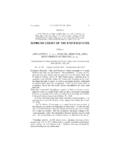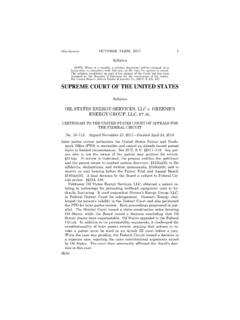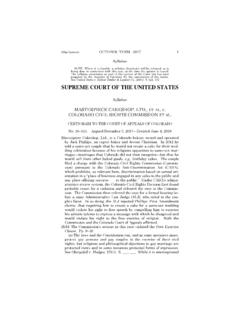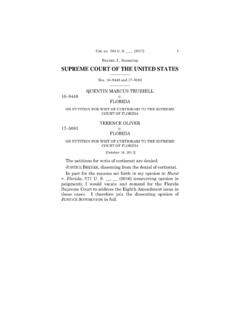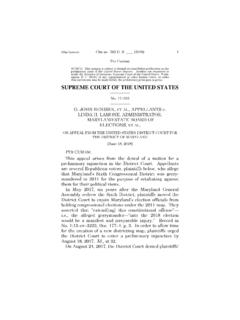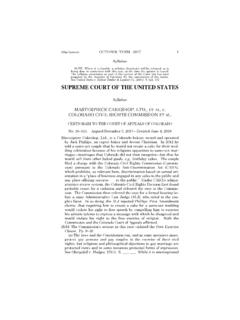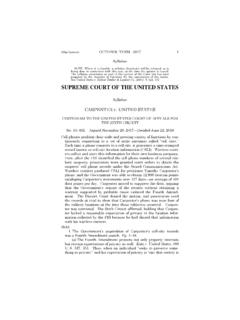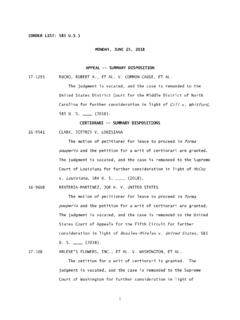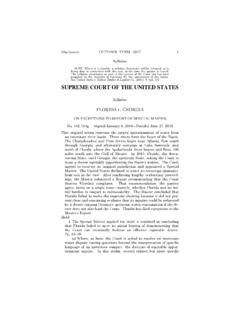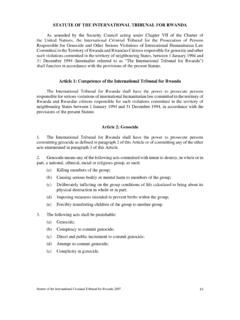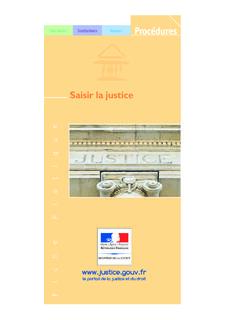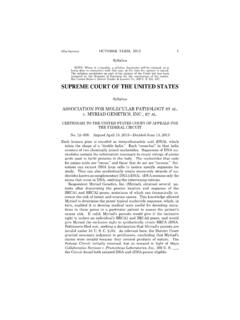Transcription of SUPREME COURT OF THE UNITED STATES
1 1 (Slip Opinion) OCTOBER TERM, 2019 Syllabus NOTE: Where it is feasible, a syllabus (headnote) will be released, as is being done in connection with this case, at the time the opinion is issued. The syllabus constitutes no part of the opinion of the COURT but has been prepared by the Reporter of Decisions for the convenience of the reader. See UNITED STATES v. Detroit Timber & Lumber Co., 200 U. S. 321, 337. SUPREME COURT OF THE UNITED STATES Syllabus DEPARTMENT OF HOMELAND SECURITY ET AL. v. REGENTS OF THE UNIVERSITY OF CALIFORNIA ET AL.
2 CERTIORARI TO THE UNITED STATES COURT OF APPEALS FOR THE NINTH CIRCUIT No. 18 587. Argued November 12, 2019 Decided June 18, 2020* In 2012, the Department of Homeland Security (DHS) issued a memo-randum announcing an immigration relief program known as DeferredAction for Childhood Arrivals (DACA), which allows certain unauthor-ized aliens who arrived in the UNITED STATES as children to apply for a two-year forbearance of removal. Those granted such relief becomeeligible for work authorization and various federal benefits. Some 700,000 aliens have availed themselves of this opportunity. Two years later, DHS expanded DACA eligibility and created a re-lated program known as Deferred Action for Parents of Americans and Lawful Permanent Residents (DAPA).
3 If implemented, that programwould have made million parents of U. S. citizens or lawful perma-nent residents eligible for the same forbearance from removal, work eligibility, and other benefits as DACA recipients. Texas, joined by 25other STATES , secured a nationwide preliminary injunction barring im-plementation of both the DACA expansion and DAPA. The Fifth Cir-cuit upheld the injunction, concluding that the program violated the Immigration and Nationality Act (INA), which carefully defines eligi-bility for benefits. This COURT affirmed by an equally divided vote, and * Together with No. 18 588, Trump, President of the UNITED STATES , et al.
4 V. National Association for the Advancement of Colored People et al., on certiorari before judgment to the UNITED STATES COURT of Appeals for the District of Columbia Circuit, and No. 18 589, Wolf, Acting Secretary of Homeland Security, et al. v. Batalla Vidal et al., on certiorari before judgment to the UNITED STATES COURT of Appeals for the Second Circuit. 2 DEPARTMENT OF HOMELAND SECURITY v. REGENTS OF UNIV. OF CAL. Syllabus the litigation then continued in the District COURT . In June 2017, following a change in Presidential administrations, DHS rescinded the DAPA Memorandum, citing, among other reasons,the ongoing suit by Texas and new policy priorities.
5 That September, the Attorney General advised Acting Secretary of Homeland Security Elaine C. Duke that DACA shared DAPA s legal flaws and should alsobe rescinded. The next day, Duke acted on that advice. Taking intoconsideration the Fifth Circuit and SUPREME COURT rulings and the At-torney General s letter, Duke decided to terminate the program. She explained that DHS would no longer accept new applications, but that existing DACA recipients whose benefits were set to expire within sixmonths could apply for a two-year renewal. For all other DACA recip-ients, previously issued grants of relief would expire on their own terms, with no prospect for renewal.
6 Several groups of plaintiffs challenged Duke s decision to rescind DACA, claiming that it was arbitrary and capricious in violation of theAdministrative Procedure Act (APA) and infringed the equal protec-tion guarantee of the Fifth Amendment s Due Process Clause. District Courts in California (Regents, No. 18 587), New York (Batalla Vidal, No. 18 589), and the District of Columbia (NAACP, No. 18 588) all ruled for the plaintiffs. Each COURT rejected the Government s argu-ments that the claims were unreviewable under the APA and that the INA deprived the courts of jurisdiction. In Regents and Batalla Vidal, the District Courts further held that the equal protection claims wereadequately alleged, and they entered coextensive nationwide prelimi-nary injunctions based on the conclusion that the plaintiffs were likely to succeed on their APA claims.
7 The District COURT in NAACP took a different approach. It deferred ruling on the equal protection chal-lenge but granted partial summary judgment to the plaintiffs on theirAPA claim, finding that the rescission was inadequately explained. The COURT then stayed its order for 90 days to permit DHS to reissue a memorandum rescinding DACA, this time with a fuller explanation ofthe conclusion that DACA was unlawful. Two months later, Duke s successor, Secretary Kirstjen M. Nielsen, responded to the COURT s or-der. She declined to disturb or replace Duke s rescission decision and instead explained why she thought her predecessor s decision was sound.
8 In addition to reiterating the illegality conclusion, she offered several new justifications for the rescission. The Government moved for the District COURT to reconsider in light of this additional explana-tion, but the COURT concluded that the new reasoning failed to elaboratemeaningfully on the illegality rationale. The Government appealed the various District COURT decisions to the Second, Ninth, and D. C. Circuits, respectively. While those ap-peals were pending, the Government filed three petitions for certiorari 3 Cite as: 591 U. S. ____ (2020) Syllabus before judgment.
9 Following the Ninth Circuit affirmance in Regents, this COURT granted certiorari. Held: The judgment in No. 18 587 is vacated in part and reversed inpart; the judgment in No. 18 588 is affirmed; the February 13, 2018 order in No. 18 589 is vacated, the November 9, 2017 order is affirmed in part, and the March 29, 2018 order is reversed in part; and all of the cases are remanded. No. 18 587, 908 F. 3d 476, vacated in part and reversed in part; No. 18 588, affirmed; and No. 18 589, February 13, 2018 order vacated, No-vember 9, 2017 order affirmed in part, and March 29, 2018 order re-versed in part; all cases remanded. THE CHIEF JUSTICE delivered the opinion of the COURT , except as to Part IV, s rescission decision is reviewable under the APA and is within this COURT s jurisdiction.
10 Pp. 9 13.(a) The APA s basic presumption of judicial review of agency ac-tion, Abbott Laboratories v. Gardner, 387 U. S. 136, 140, can be rebut-ted by showing that the agency action is committed to agency discre-tion by law, 5 U. S. C. 701(a)(2). In Heckler v. Chaney, the COURT held that this narrow exception includes an agency s decision not to insti-tute an enforcement action. 470 U. S. 821, 831 832. The Government contends that DACA is a general non-enforcement policy equivalent tothe individual non-enforcement decision in Chaney. But the DACA Memorandum did not merely decline to institute enforcement proceed-ings; it created a program for conferring affirmative immigration re-lief.
